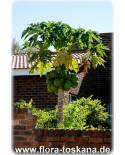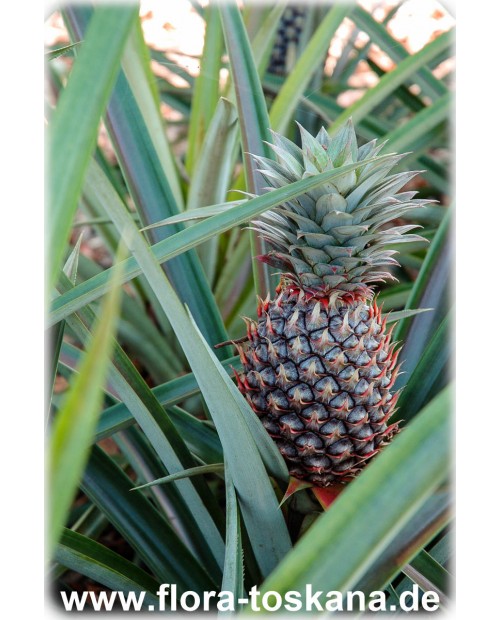Carica papaya - Papaya
If you don't have much space in your conservatory, a papaya (Carica papaya) with its slender, mostly single-stemmed growth and large, lobed leaves will yield generous harvests of yellow/orange-skinned papaya fruit. Tropical fruits from home.
Papaya (Carica papaya) inherently grows with a single stem and quickly. Cultivated in a pot or winter garden it can grow up to 2-3 m. At the stem’s top a limited amount of leaves grows on long stalks. Generally, for each new leaf grown at the top an older leaf further down the stem will be dropped. Most of the varieties cultivated in this country are hermaphroditic, which means they grow male and female flowers in the upper leaf axils of each plant. Pollination works out well and can be even improved by transfering the pollen with a brush. Even in this country, the fruits can reach a length of 20 cm and more, with a weight of about one kilogramme. They are ripe when the peel changes colour to orange-yellow and softens at slight pressure. They can then be easily detached from its stalk with a rotary movement. Scrape out the seeds at the fruit’s center with a spoon and then enjoy the melon-like, sweet flesh of fruit. The own harvest usually tastes much more intensive than fruits that you can buy in a shop and that have been harvested before they were ripe. The peel of such fruits will still ripen but not the aroma. Customers repeatedly reported us a harvest of up to 10 fruits with a weight of about one kilogram each. For heatlhy plants it is important to provide a constant soil moisture and an air humidity of above 60 % as well as permanently warm temperatures. To the change of position and with it the settling in, Papaya react with dropping their leaves. New leaves, however, will grow again quickly. The plant’s location should not be in full sun because the soft leaves will then suffer a sunburn. During summer Papaya requires plenty of water, whereas in winter only little water. Make sure that the soil is not too moist because in that case the roots and the stem might start to rot.![]() Quality: very big fruits with orange peel; distinctive habit; slim tree top; growing quickly
Quality: very big fruits with orange peel; distinctive habit; slim tree top; growing quickly![]() Use:all year in a heated greenhouse or bright room
Use:all year in a heated greenhouse or bright room
Data sheet
- Family
- Caricaceae
- Origin
- South Amercia
- Flowering period
- Summer
- Color of flowers
- Yellow
- Fruits
- Edible fruits
- Growth
- Tree
- Location
- Everywhere
- winter temperature
- 20 (+/- 5) °C
- Minimum temperature
- 5 °C
- Hardiness Zones
- 10
- Height
- 4 - 5 m
You might also like
Customers who bought this product also bought:





































































